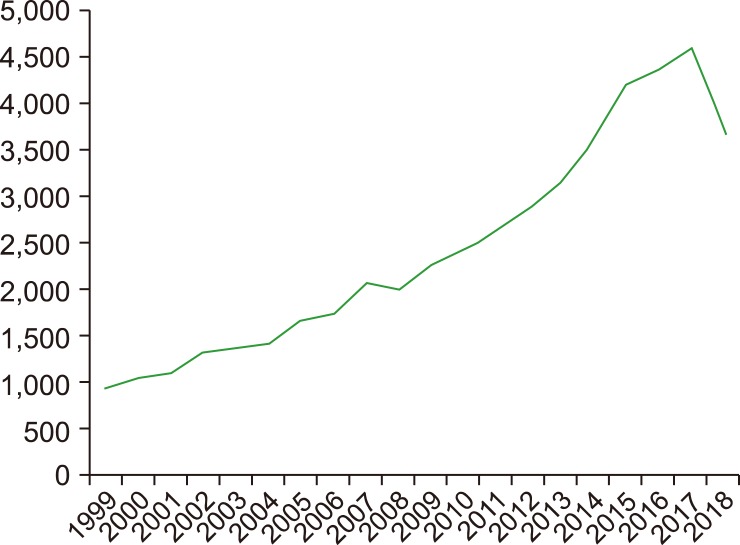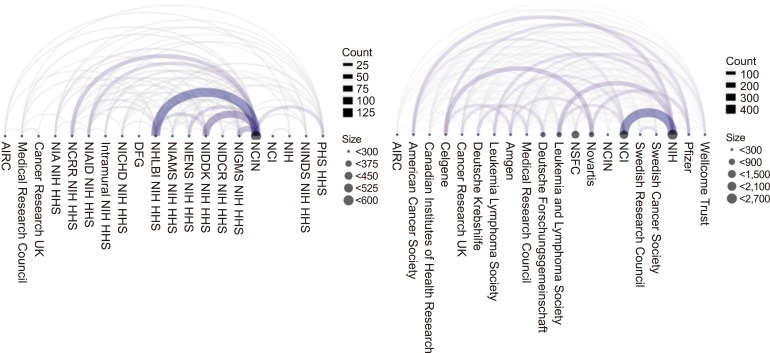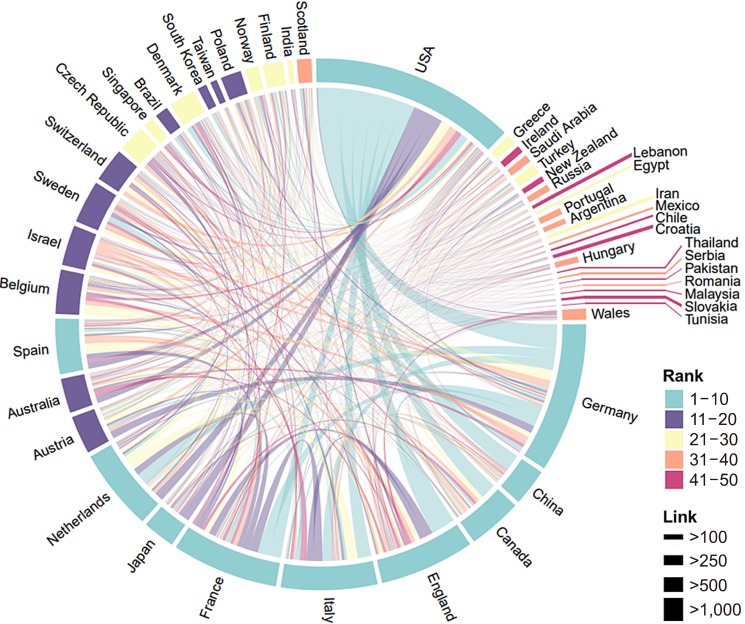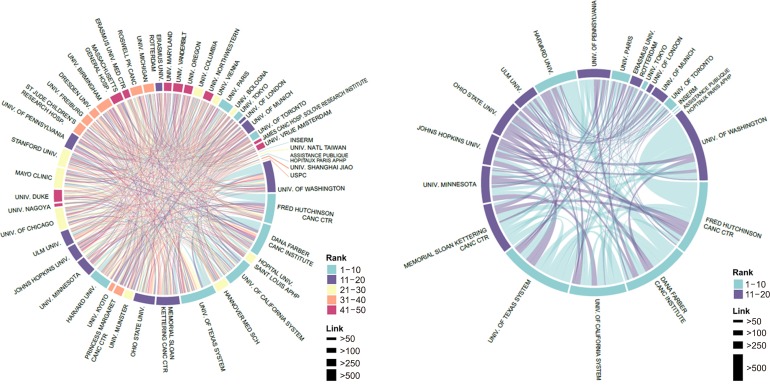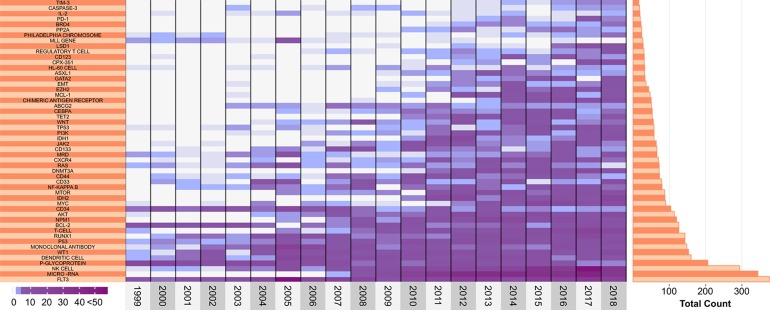Blood Res.
2020 Mar;55(1):1-9. 10.5045/br.2020.55.1.1.
Bibliometric analysis of studies about acute myeloid leukemia conducted globally from 1999 to 2018
- Affiliations
-
- 1Department of Public Health, Graduate School, Korea University, Seoul, Korea. eunil@korea.ac.kr
- 2Department of Clinical Pharmacy, Graduate School, Cha University, Seoul, Korea.
- 3Graduate School of Interdisciplinary Management, Ulsan National Institute of Science and Technology, Ulsan, Korea.
- KMID: 2472002
- DOI: http://doi.org/10.5045/br.2020.55.1.1
Abstract
- A bibliometric study is performed to analyze publication patterns in a specific research area and to establish a landscape model that can be used to quantitatively weigh publications. This study aimed to investigate AML research networks and to conduct a trend-related keyword analysis. We analyzed 48,202 studies about AML published from 1999 to 2019 in the Web of Science Core Collection. The network analysis was conducted using the R&R studio software. The journal Blood had the highest number of published articles with an h-index of 410. The USA had the highest number of total publications (18,719, 38.3%) and research funded by the government, institutions, and pharmaceutical companies (5,436, 10.8%). The institute with the largest number of publications was the MD Anderson Cancer Center. Kantarjian H, Garcia-Manero G, and Ravandi F were the leading authors of publications about AML. Keyword analysis revealed that FLT 3, micro-RNA, and NK cell topics were the hotspots in the cell and gene area in all publications. The overall AML research landscape is popular in the field of translational research as it can identify molecular, cell, and gene studies conducted by different funding agencies, countries, institutions, and author networks. With active funding and support from the Chinese government, the productivity of scientific research is increasing not only in the AML field but also in the medical/health-related science field.
MeSH Terms
Figure
Reference
-
1. Short NJ, Rytting ME, Cortes JE. Acute myeloid leukaemia. Lancet. 2018; 392:593–606. PMID: 30078459.
Article2. Papaemmanuil E, Gerstung M, Bullinger L, et al. Genomic classification and prognosis in acute myeloid leukemia. N Engl J Med. 2016; 374:2209–2221. PMID: 27276561.
Article3. Grimwade D, Hills RK, Moorman AV, et al. Refinement of cytogenetic classification in acute myeloid leukemia: determination of prognostic significance of rare recurring chromosomal abnormalities among 5876 younger adult patients treated in the United Kingdom Medical Research Council trials. Blood. 2010; 116:354–365. PMID: 20385793.
Article4. Ding L, Ley TJ, Larson DE, et al. Clonal evolution in relapsed acute myeloid leukaemia revealed by whole-genome sequencing. Nature. 2012; 481:506–510. PMID: 22237025.5. De Kouchkovsky I, Abdul-Hay M. Acute myeloid leukemia: a comprehensive review and 2016 update. Blood Cancer J. 2016; 6:e441. PMID: 27367478.
Article6. Döhner H, Estey E, Grimwade D, et al. Diagnosis and management of AML in adults: 2017 ELN recommendations from an international expert panel. Blood. 2017; 129:424–447. PMID: 27895058.
Article7. National Cancer Institute. SEER Cancer Stat Facts: Leukemia - acute myeloid leukemia (AML). Bethesda, MD: National Cancer Institute;2018. Accessed October 3, 2019. at https://seer.cancer.gov/statfacts/html/amyl.html.8. Appelbaum FR, Gundacker H, Head DR, et al. Age and acute myeloid leukemia. Blood. 2006; 107:3481–3485. PMID: 16455952.
Article9. Shah A, Andersson TM, Rachet B, Björkholm M, Lambert PC. Survival and cure of acute myeloid leukaemia in England, 1971-2006: a population based study. Br J Haematol. 2013; 162:509–516. PMID: 23786647.10. Deschler B, Lübbert M. Acute myeloid leukemia: epidemiology and etiology. Cancer. 2006; 107:2099–2107. PMID: 17019734.
Article11. Yates J, Glidewell O, Wiernik P, et al. Cytosine arabinoside with daunorubicin or adriamycin for therapy of acute myelocytic leukemia: a CALGB study. Blood. 1982; 60:454–462. PMID: 6953986.
Article12. Stein EM, Tallman MS. Emerging therapeutic drugs for AML. Blood. 2016; 127:71–78. PMID: 26660428.
Article13. Lin TL, Levy MY. Acute myeloid leukemia: focus on novel therapeutic strategies. Clin Med Insights Oncol. 2012; 6:205–217. PMID: 22654526.
Article14. Raj RV, Abedin SM, Atallah E. Incorporating newer agents in the treatment of acute myeloid leukemia. Leuk Res. 2018; 74:113–120. PMID: 30401522.
Article15. Web of Science Group. Web of Science core collection: Web of Science: summary of coverage. Philadelphia, PA: Clarivate Analytics;2019. Accessed October 3, 2019. at https://clarivate.libguides.com/woscc/coverage.16. Csárdi G. Package ‘igraph’: network analysis and visualization 1.2.4.1. igraph, 2019. Accessed April 22, 2019. at https://cran.rproject.org/web/packages/igraph/igraph.pdf.17. Vardiman JW, Thiele J, Arber DA, et al. The 2008 revision of the World Health Organization (WHO) classification of myeloid neoplasms and acute leukemia: Rationale and important changes. Blood. 2009; 114:937–951. PMID: 19357394.
Article18. Vardiman JW. The World Health Organization (WHO) classification of tumors of the hematopoietic and lymphoid tissues: an overview with emphasis on the myeloid neoplasms. Chem Biol Interact. 2010; 184:16–20. PMID: 19857474.
Article19. Leone G, Fianchi L, Pagano L, Voso MT. Incidence and susceptibility to therapy-related myeloid neoplasms. Chem Biol Interact. 2010; 184:39–45. PMID: 20026017.
Article20. Porwit A. Role of flow cytometry in diagnostics of myelodysplastic syndromes-beyond the WHO 2008 classification. Semin Diagn Pathol. 2011; 28:273–282. PMID: 22195405.
Article21. Vardiman J. The classification of MDS: From FAB to WHO and beyond. Leuk Res. 2012; 36:1453–1458. PMID: 22940257.
Article22. Web of Science Group. Technical question or report a problem. Philadelphia, PA: Clarivate Analytics;2019. Accessed October 3, 2019. at https://support.clarivate.com/ScientificandAcademicResearch/s/?language=en_US.23. National Center for Health Statistics. Estimates of funding for various research, condition, and disease categories (RCDC). Bethesda, MD: National Institutes of Health;2019. Accessed October 3, 2019. at https://report.nih.gov/categorical_spending.aspx.24. UK Research and Innovation. Funding opportunities. Swindon, UK: UK Research and Innovation;2019. Accessed February 1, 2019. at https://www.ukri.org/funding/funding-opportunities/.25. Ibrahim JK, Sorensen AA, Grunwald H, Burris S. Supporting a culture of evidence-based policy: federal funding for public health law evaluation research, 1985-2014. J Public Health Manag Pract. 2017; 23:658–666. PMID: 28538338.
Article26. Chinese national innovation funding programmes. Brussels, Belgium: the European Union;2019. Accessed October 3, 2019. at http://chinainnovationfunding.eu/chinese-national-innovation-funding-programmes/.27. Ball P. Index aims for fair ranking of scientists. Nature. 2005; 436:900. PMID: 16107806.
Article28. Hirsch JE. An index to quantify an individual's scientific research output. Proc Natl Acad Sci U S A. 2005; 102:16569–16572. PMID: 16275915.
Article29. Bradford SC. Sources of information on specific subjects. Journal of Information Science. 1985; 10:173–175.
- Full Text Links
- Actions
-
Cited
- CITED
-
- Close
- Share
- Similar articles
-
- Current treatment for pediatric acute myeloid leukemia
- Acute Myeloid Leukemia with Intracardiac Thrombus Presenting as Acute Limb Ischemia
- Molecular Biology of Childhood Acute Myeloid Leukemia with Emphasis on Chromosomal Translocation
- Myeloid Sarcoma of Peritoneum in Acute Myeloid Leukemia Patient with Inversion of Chromosome 16
- A Case of Myeloid Sarcoma Preceding the Diagnosis of Acute Myeloid Leukemia

